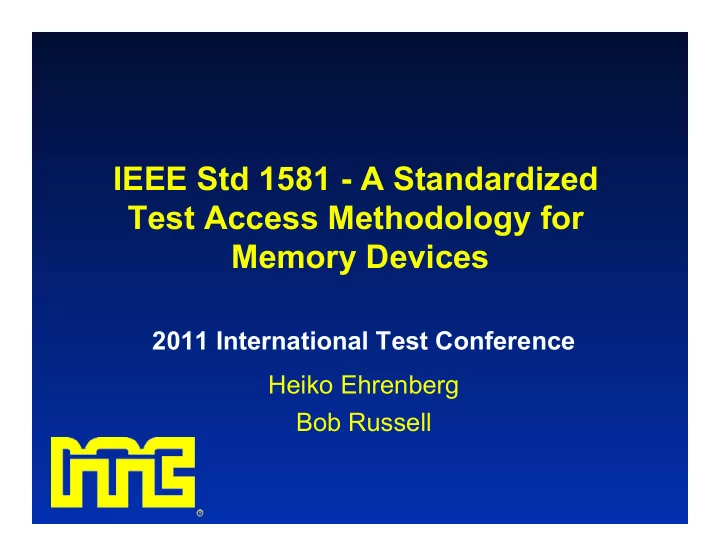

IEEE Std 1581 - A Standardized Test Access Methodology for Memory Devices 2011 International Test Conference Heiko Ehrenberg Bob Russell
Purpose • Provide an overview of IEEE Std 1581: – Test mode control methods – Examples of IEEE 1581 test functions – Examples of test logic implementations – Possible future extensions ITC 2011 – paper 5.3 Slide #2
Outline • History of IEEE Std 1581 • Defects addressed by IEEE Std 1581 • Key elements of IEEE Std 1581 • IEEE 1581 test mode control methods • IEEE 1581 test functions • Outlook ITC 2011 – paper 5.3 Slide #3
History of IEEE Std 1581 2003 2006 2001 2010 2011 1999 IEEE Std 1581 published in June 2011 The PAR was extended twice in order to complete the standard development effort. ITC 2011 – paper 5.3 Slide #4
Defects addressed by IEEE Std 1581 Bridging fault Vcc (stuck-at-1) GND (stuck-at-0) IEEE 1149.1 IEEE 1581 Open fault compliant compliant device device Bridging fault Vcc (stuck-at-1) GND (stuck-at-0) Open fault Bridging fault ITC 2011 – paper 5.3 Slide #5
Key elements in IEEE Std 1581 • Simple test logic implementation for complex, slave-type devices • No extra pins required • No reliance on complex access cycles • Fast test execution, small test vector set • Usable with any access methodology (Boundary scan, functional, ICT) ITC 2011 – paper 5.3 Slide #6
Basic concept PCB IEEE 1581 device Optional Memory Test Control Test Pin Controller TTM (optional) (if no TTM) Input Memory Cells Bus x IEEE 1149.1 device(s) Combinational Test Logic y Output Bus ITC 2011 – paper 5.3 Slide #7
Test mode control • One of seven transparent test mode (TTM) control methods: Test entry or exit is – Non-functional stimulus (NFS) triggered by a condition on the pins that would – Designated command codes (DCC) otherwise never exist – Simultaneous input/output (SIO) under normal functional conditions – Clock frequency (CKF) These methods may – Analog level (ANL) require additional board- level and/or controlling – Conditional power-up initiation (CPI) device DFT to be implemented – Default power-up initiation (DPI) or a Dedicated test pin (TPN) • ITC 2011 – paper 5.3 Slide #8
Test mode control – NFS example /WE /Write Enable /CS /Chip Select IEEE 1149.1 IEEE 1581 device device < 100 µ s ≥ 150 µ s /WE Exit Enter test mode test mode /CS ITC 2011 – paper 5.3 Slide #9
Test mode control – DCC example MDS2 Mode2 MDS1 Mode1 STB Strobe IEEE 1149.1 IEEE 1581 device device MDS2 MDS1 Mode / description 0 0 Read STB = Strobe: 0 1 Write triggers capture of 1 0 Enter IEEE 1581 test mode mode selection bits 1 1 Exit IEEE 1581 test mode ITC 2011 – paper 5.3 Slide #10
Test mode control – CPI example /WE /Write Enable & /CS & /Chip Select Non-Volatile IEEE 1149.1 IEEE 1581 PCB DFT device device control Test mode is entered if a predetermined set of logical input states exist at a predetermined period after device power-up. ITC 2011 – paper 5.3 Slide #11
Test logic • One of three defined test logic architectures: – XOR (3-input XOR or XNOR gates) – IAX (XOR, Inverters, and AND gates) – XOR-2 (2-input XOR or XNOR gates) • Or a custom test logic that satisfies rules in IEEE Std 1581-2011 ITC 2011 – paper 5.3 Slide #12
Test logic example - XOR Inputs Outputs IEEE 1581 memory device I1 XOR I2 O1 I3 I4 XOR I5 O2 I6 XOR O3 XOR O4 ITC 2011 – paper 5.3 Slide #13
Optional test functions • Optional test functions accessible via Test Pattern Partitioning (TPP) • Examples include: – Reading a device identification (ID) – Control line continuity test – Built-in self test (BIST) access – Other public or private commands ITC 2011 – paper 5.3 Slide #14
Outlook for IEEE Std 1581 • IEEE Std 1581 approved March 2011 and published in June 2011 • Working group is considering future work: – Description language – Bi-directional test features – … • More details possibly at BTW 2011 ITC 2011 – paper 5.3 Slide #15
Thank you For more details and questions, or to join the working group, contact the authors: Heiko Ehrenberg (h.ehrenberg@ieee.org) Bob Russell (r.russell@ieee.org) ITC 2011 – paper 5.3 Slide #16
Recommend
More recommend